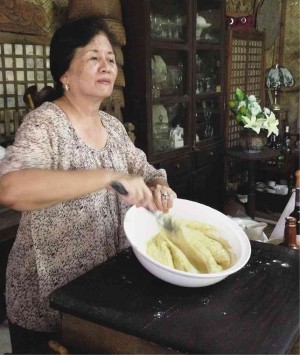
LILLIAN Borromeo of Cucinang Matua (Old Kitchen) prepares a Kapampangan delicacy, the “Panecillos de Saniculas” or the San Nicolas de Tolentino cookies. PHOTOS BY TONETTE OREJAS
Either for nourishment or pleasure or both, spend the last days of summer sampling heirloom recipes in Pampanga province.
It won’t take much of your time. The food trip prepared by the Culinarium of the Museo ning Angeles last week as part of the International Museum Day celebrations took less than a day.
The tour, done with a lot of tasting and eating, began at an old house in Barangay (village) San Jose in Sta. Rita town.
This was where Felisa Ocampo-Lansang had made turrones de casuy and sans rival since the 1920s, a skill she learned from a Dominican nun from Spain who shared the recipes with her and several women. It was the nun’s way of thanking them for sewing the priest’s vestments for free.
The tradition of making these pagmayumu (sweet snacks or desserts) continues because she had trained a nephew, retired Salesian teacher Ramon Ocampo, before she died at age 97 in 1998.
Now, Ocampo, 73, has 15 employees who prepare the sweets by hand using the original recipes.
Turrones de casuy is a bar of cashew and milk wrapped in thin sheets made from egg white and flour, very much like the ostia (host) received during holy Masses.
Sans rival, topped with cashew, still uses the same brand of butter spread over a baked layer of cashew and milk.
“Even Mt. Pinatubo’s eruptions [in 1991] did not stop the people’s craving for turrones de casuy and sans rival. We just had to ring this house with sandbags to protect it from lahar,” Ocampo said.
The next stop is the patku and burquillos by Miriam Mercado who lives in the same village. Adela Galang, her grandmother, handed down the recipe to her.
Patku, a child’s mispronunciation of pasku (Christmas), can be likened to a native crepe. Mercado’s patku is made of carabao milk, lemon, butter, cheese and grounded rice. These ingredients produce a wrapper that, when cooked, is filled with young shredded coconut.
In making the burquillos, she uses a small metal apparatus, an improved version of Galang’s tool.
Mercado also makes uraro cookies, special pan de sal, tsokolateng batirol, okoy, atchara, panara, bibingka, puto bumbong, empanada, mamon tostado and masa padrida.
Lunch was at Cucinang Matua (Old Kitchen) of Lillian Mercado-Lising Borromeo beside the Hizon-Lorenzo bale maragul (ancestral house) in Barangay Parian in Mexico town. Her place has no signboard whatsoever so it’s better to watch out for the second street to your left before reaching the town proper.
Before the meal, she showed her guests how to make the Panecillos de Saniculas (San Nicolas de Tolentino cookies). Borromeo is among the few last makers of these delicacies. She has modified the recipe but still uses antique wooden molds.
Nostalgic feel
There’s a nostalgic feel to the place because the demonstration is done in her family’s museum of kitchen utensils, cooking wares and tools. Borromeo has all these in her care because she’s the only woman in a brood of four.
She has prepared sisig matua, bulanglang bangus, kilayin, tidtad, pindang babi, bobotung asan, paku salad, bringhi, buru and gule baryu, ningnang asan, paksing demonyu from recipes learned from her mother Francisca and grandaunt Maura Lorenzo.
Borromeo said she hasn’t kept the recipes to herself. She has published the second edition of “Atching Lillian’s Heirloom Recipes (Romancing the Past through Traditional Calutung Capampangan).”
Aside from 200 or so recipes, the book includes the first local translation of Dr. Jose Rizal’s “Mi Ultimo Adios.” Rizal and Borromeo’s grandfather, poet and revolutionary Don Monico Mercado, are cousins.
The culinary tour ended at Camalig Restaurant in Angeles City where two varieties of Armando’s Pizza were served with buko sherbet and sago’t gulaman.
Rich culinary traditions
The Philippines has rich culinary traditions, Felice Prudente-Sta. Maria, who has over 40 years of active heritage and cultural work, said in a lecture organized also by the Museo ning Angeles.
Filipinos, she said, enjoy eating with others, customize their food, relish new food and drinks, and have traditions for rice, kakanin, lumpia, spaghetti and adobo.
“Every generation relearns from the elders. The challenge now is to establish criteria,” she said.
Food, she said, provides signs of the nobleness and honor of a race, evident in how people handle hunger, treat food producers and compensate food sources and services.
“Your tummy tells you that it’s great being a Filipino,” she said.
Chef, writer and artist Claude Tayag said the Kapampangan did not claim to be the best cooks around. Outsiders who tasted local food bestowed the title, he said.
The destinations of food trips in Pampanga can be varied. One can go to Tayag’s Bale Dutung, also in Angeles City, at Abe’s Farm in Magalang town, Everybody’s Cafe in the City of San Fernando or to several restaurants offering specialty dishes.
[For food tours on weekends or weekdays, summer or rainy days, contact Joy Cruz of Museo ning Angeles at 0943-2623950 or Poch Jorolan, 0917-5108961 and 0999-9948634.]